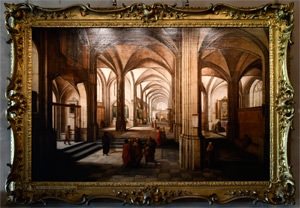Petworth House in West Sussex is a place of superlatives. It is a Grade I house (meaning a property of exceptional interest). It contains one of the National Trust’s largest collections of paintings and sculptures. It is surrounded by a park containing the largest herd of fallow deer in England. In the Molyneux globe, which visitors can almost press their noses up against, the country has the oldest English terrestrial globe in existence.
With more classical marble statues, and more sea and landscapes by J.W.M. Turner than in almost any comparable house, Petworth is dizzyingly full of art. Yet from the outside, you would not know it: the house’s principal west face is plain and sober, belying little of the wonders that can be found inside. Petworth is no Waddesdon: there are no countless turrets, domes and finials, no excessive external adornment. To my eye, this is not England’s Versailles. And in truth, within easy reach of the South Downs, Petworth’s setting says as much as the outward face of the house ever could. The great ‘Capability’ Brown ensured this by insisting in the mid-1700s that a bustle of formal gardens be swept away, opening the vista to a simplified English pastoral scene.
To emerge from the house, eyes ablink with images of marble poses and old master portraits, the open sweep of undulating landscape supervised by centenarian oaks and chestnuts is timeless. The house’s outside and its inside dish out compatible therapies.
Petworth’s art collection
The roll call of the art and sculpture at Petworth could compete with any major gallery in the land. There are north of 600 paintings, more than in any other National Trust house. Petworth also contains “the largest Grand Tour collection of antique statuary still in its original setting”, according to the lavish guide book. To that was added early 19th century British sculpture commissioned by the 3rd Earl of Egremont.
One can get up close to more than 20 paintings by or after Van Dyck and 20 by J.M.W. Turner. There is work by Bosch, Titian, Reynolds, Blake, Holbein’s studio, Teniers, Claude, Bellotto and countless others.
The marble sculptures in Petworth’s various galleries (and throughout the house) are exceptional. The stand-out pieces are perhaps St. Michael overcoming Satan (1826) by John Flaxman and Adonis and the Bear (also 1826) by John Edward Carew.
Grinling Gibbons’s The Carved Room
The talented and fashionable Dutch wood carver Grinling Gibbons was employed by Charles Seymour the 6th Duke of Somerset to decorate Petworth’s Carved Room. Gibbons was thought of as the ‘King’s Carver’ because William III and Mary II had already commissioned him to create the carvings at Kensington Palace and Hampton Court. The Duke was therefore making explicit his loyalty to the throne. Indeed, there is one section of carving that clearly shows sheet music from The Fairy-Queen by Henry Purcell which was written to celebrate the wedding anniversary of William and Mary.
The carvings were executed in lime wood in the 1690s, a wood perfectly suited to the task by virtue of its relative softness and crispness. The wood’s close grain makes it perfect for creating intricate shapes. The lime would originally have had a light cream colouration which darkened with age and the effect of light. The oak panels behind the carvings were painted white in the 1820s to help show the carvings off to even greater effect. This was eventually removed in 1871. When ‘Capability’ Brown planted spruce, cedar, larch and lime in Petworth Park in the mid-1800s, he would have known the significance of choosing lime.
Along with the obligatory heraldic and ducal motifs, there are more playful elements: a fox chases a rabbit, a cat chases a bird. Fruit, game and sea food adorn what was sometimes used as a dining room. One can also spot several pea pods where the peas are visible. Gibbons famously left pea pods unopened on projects where the client hadn’t paid, so the visible peas at Petworth speak favourably of this particular patron.
Petworth’s Carved Room is so much longer than it is deep that is it genuinely difficult to grasp the arrangement of panels on the longest, east wall. One can see seven full-length portraits, the central portrait of Henry VIII from the studio of Hans Holbein flanked on either side by a further pair. Under each of these outer four portraits are four paintings commissioned of Turner by the Earl of Egremont specifically for the Carved Room. In a total of nine separate panels, there are four other panels containing smaller portraits and busts. Each is interleaved with Gibbons’s flamboyant, three-dimensional carvings. Marble tables and plinths display classical busts in a symetrical array on either side of a central fireplace.
Gibbons’s carvings burst off their containing panels, fanfares of heraldry and whimsy, soberly aristocratic, playfully organic, the heavenly and the earth-bound side-by-side. One’s gaze rarely rests long before being pulled to an adjacent detail. Fixing the whole is pleasantly bedevilled by any of the many parts. It’s intoxicating.
One can photograph the lot in one perspective sweep or in vertical slices face-on. None convey the complexity and balance of the whole, so here’s a panorama stitched together from a sequence of separate photographs. This offers what the visitor can barely see in one go, incidentally made possible by visiting Petworth when numbers were limited by pandemic social distancing. Click/tap for the larger version:
Links
- Petworth House on The National Trust’s website.
- Art and the Country House - Petworth.
- Solid, Liberal, Rich and English: The Patriotic Patronage and Curatorship of the Third Earl of Egremont, an essay by Andrew Loukes.
- Light and ‘Enlightened Patronage’: The Sculpture Galleries at Petworth, an essay by L.G. Sullivan.
- The BBC’s The Glorious Grinling Gibbons - Carved with Love, on YouTube.
- The Master Carvers Association’s tribute to Grinling Gibbons.
- A modern-day Grinling Gibbons.
- The exquisite private gardens at Petworth House.























